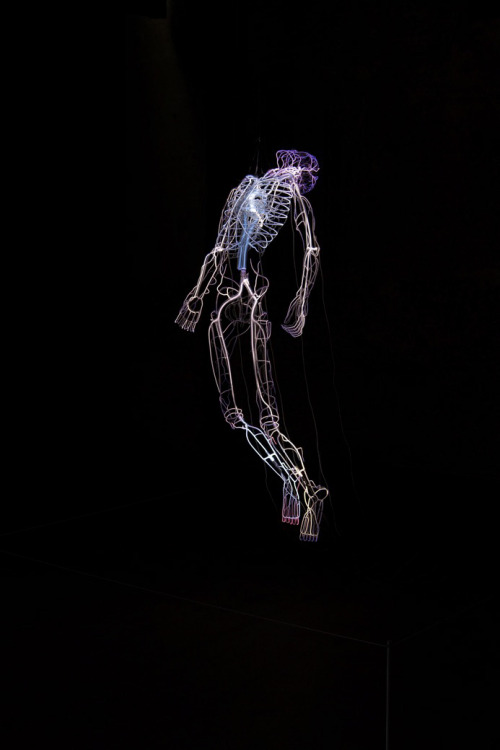Have you had a bad week? Has it been trying, grinding, wearing and soul-scouring? Do you need a pick-me-up, something to leaven the spirits and the soul, and lighten the ever-more-burdensome existential load of being made of meat here in the early days of the fag-end of human civilisation?
Yeah, sorry, me too, I got NOTHING. The one silver lining for me in the past seven days has been knowing that however boring, pointless and enervating my professional existence might be, at least I wasn’t one of the (doubtless many hundreds of) people involved in making the brand collaboration between plastic cheese peddlers Kraft and musician Kelis, a partnership so staggeringly-awful and ineptly-conceived that it made me feel almost sorry for whichever poor accountmonkey is going to have to present the ‘results’ wrapup.
Basically, gentle readers, I am at a stage in my life where I go to bed each night praying for an intervention from Sam Beckett (the fictional time traveller, not the Irish playwrite (although tbh either would do at this stage – mind you, I’m not convinced Irish Sam would necessarily leave my life in better conditions than he found it)). If anyone has a number for Scott Bakula, please do send it my way.
I am still Matt, but only just; this is still Web Curios, regrettably; who the fcuk are you, and what are you looking at me like that for?

WE KICK OFF THIS WEEK WITH A CRACKING MIX OF GARAGE-ISH TUNES BY OPPIDAN!
THE SECTION WHICH THIS WEEK HAS MOSTLY ENJOYED THE ETHICAL STYLINGS OF SOME OF THE WORLD’S LARGEST COMMS AGENCIES, PT.1:
- 1920: One of the curious things about the past three weeks has been the reemergence of Anonymous as a collective in the popular consciousness. We’d all sort of forgotten about Anonymous, hadn’t we? It feels a bit like a relic of a past internet, one when we imagined that collective, scrappy resistance was A Thing that could Make A Difference (oh the naivety!) rather than just another example of flailing impotence in the face of The Great Grinding Forces That Govern Us And In So Doing Render Us So Much Psychic Mincemeat. Remember when we thought that a bunch of script kiddies wearing Alan Moore-inspired Guy Fawkes masks could save us? LOL! I jest, obvs (please don’t take down Web Curios, Anonymous!), but I have been genuinely fascinated to see the collective’s reemergence as a vector of anti-Russian resistance in the weeks since Putin’s invasion. 1920 is a project set up by Anonymous which uses leaked databases of Russian mobile numbers to enable anyone to send messages to Russian citizens to educate them about what is really happening in Ukraine, via SMS or WhatsApp messages – similar in ethos to those adland people who are trying to use digital advertising to break through the propaganda wall being erected around the country by Moscow (full disclosure – I know some of these people, though I am not personally involved in the work). This is a really interesting idea, as is this parallel project which is hacking CCTV cameras across Russia to make them display overlaid messages of support for Ukraine. I’ve a suspicion the 1920 site isn’t quite working properly at the time of writing, but it’s worth checking back if you’re curious about getting involved in some way.
- SUCHO: Or ‘Saving Ukraine’s Cultural Heritage Online’. “We are a group of cultural heritage professionals – librarians, archivists, researchers, programmers – working together to identify and archive at-risk sites, digital content, and data in Ukrainian cultural heritage institutions while the country is under attack. We are using a combination of technologies to crawl and archive sites and content, including the Internet Archive’s Wayback Machine, the Browsertrix crawler and the ArchiveWeb.page browser extension and app of the Webrecorder project” This is something I hadn’t even momentarily considered, but is an obvious side-effect of modern conflict – the degradation of digital records as servers get blown to smithereens – and I think there’s something quietly amazing about the collective effort to preserve as much as possible through open-source archiving efforts. There are hundreds of urls being submitted – it’s sort-of incredible to see history and culture being reshaped like this (‘incredible’ in the literal, not-necessarily-entirely-positive sense).
- The War Diary of Yevgenia Belorusets: Literally what it says in the title: “Yevgenia Belorusets has been one of the great documentarians of Russia’s war against Ukraine since 2014, winning the International Literature Prize for her work. Her diary provides the news from a different vantage.” This is beautiful and horrible and remarkable – each day’s update is a few-hundred words, presenting a small vignette from Beloruset’s quotidian experience of living in a warzone, and there are entries each day since 24th February. I can’t pretend this is anything other than an incredibly sad and harrowing read, but it’s also a remarkable ongoing record of what it’s like to live through an invasion – there’s no entry for 17th March, which I am hoping quite hard is down to Non-Fatal Circumstances Beyond The Author’s Control.
- Try Your Best: We pivot now with unfortunate, whiplash-inducing speed (you think context collapse is a new thing? Ha! Curios has been specialising in the unpleasant flattening of significance and meaning since 2011, fools!) from war to branding. Try Your Best is not only a terrible, silly idea, but it’s a terrible, silly idea that recycles previous terrible, silly ideas from about a decade ago, so WELL DONE everyone involved! The premise here is a GOOD ONE – “Influence the brands you love *and* get rewarded for doing it.” I mean, who doesn’t dream of influencing brands? And who doesn’t, somewhere in their cold dead heart, feel a deep and abiding love for said brands? NO FCUKER, that’s who! Combining a whole host of largely-meaningless buzzphrases (‘Community’! ‘Coins’!), the basic premise here is that TYB will provide brands with a space in which to ENGAGE their fans, test out new products and content, co-create new designs…for which ENGAGEMENT fans will earn BRAND COINS that can then be exchanged for…er…more brand stuff! What exactly the appeal is meant to be for people here is…not obvious to me (act as an unpaid branding consultant for a major corporation in exchange for magic company scrip which you can pay back to said major corporation in exchange for…branded tat? SIGN ME UP!), and I feel it’s important to remember that this is exactly the same sort of crap that people like me told clients that they could use Facebook Pages and Facebook Groups for at various points over the past decade or so. We were lying then, and these people are lying now – NOONE WANTS TO ENGAGE WITH A BRAND IN EXCHANGE FOR MAGIC BEANS, NOT EVEN IF YOU THROW THE WORD ‘CRYPTO’ IN THERE SOMEWHERE. Think about all the companies we’ve seen over the past 10 years who have touted some sort of variant on the ‘we’re a platform that rewards users for watching your branded content by paying them actual money for their time and attention, thereby ensuring the dissemination of your messaging across key audience verticals!’ – now take a minute to think how many of said companies you ever heard of more than once. Exactly. Still, ‘coins’! ‘Community’! MILLIONAIRES BY CHRISTMAS!
- Hoxna: Another variant on the ‘we’re creating a company to help you buy digital rights to real-world locations’ business model, Hoxna “is a ground-breaking and ambitious new project which links virtual and physical real estate through a common currency and NFTs (Non-Fungible Tokens), providing a true digital twin of the world.” The difference between Hoxna and previous iterations of this idea that I’ve come across is the strong link they’re trying to establish between actual, physical property ownership and digital, ‘metaversal’ (sorry) ownership – unlike other projects I’ve featured here, there’s no promise to ‘own the Eiffel Tower’ (unless you happen to, er, already own the Eiffel Tower in real life – who does own the Eiffel Tower? Can I borrow it?), which makes it feel marginally-less-grifty, but, equally, I can’t 100% get behind the idea of a company whose main vibe seems to be ‘we’re going to bring the best thing about real life – MORTGAGES!!!! – to the virtual world’ because, honestly, the increasing likelihood that all our digital futures will simply take the worst of the physical world and make it INFINITELY WORSE is starting to grate on me a bit. Could we maybe aim for a digital realm which isn’t predicated on all the asset-grabbing and scarcity/ownership models which characterise meatspace? Eh? Oh. Still, the fact that the Ts&Cs page of the site is still Lorem Ipsem gives me some small reassurance that we won’t all be in hock to the metaversal rentier class quite yet.
- Pixit: It feels, finally, like the initial frothy wave of NFT projects, specifically the infinite (and infinitely-moronic) trend for poorly-drawn profile pictures to be used as avatars in some ill-defined future digital paradise, might be dying down a bit – poor John Terry’s collection of ugly sporting primates isn’t looking like the investment he thought it was! Still, if you fancy a relatively-cheap way of creating your VERY OWN ugly NFT avatar, Pixit might be the perfect tool with which to do so – upload any image you like, and the site creates a pixellated version of it (you can choose how pixelated you want it to be – from ‘an unknowable mass of coloured blobs’ to ‘looks like a slightly-zoomed-in Amiga sprite) – you can then mint said image to the blockchain for (at the time of writing) about 20 quid and it will be YOURS FOREVER. Or, alternatively, you can just right-click and save and it will ALSO be yours forever – your call really. I particularly like the idea of using this to create a new range of Pixelated Bored Apes and then aggressively suggesting to the fools who have shelled out for the ‘real’ ones that yours are in fact the new and genuine hotness of the NFT PFP scene (but then I’m childish like that).
- The Lonely Ape Dating Club: Is this really A Thing? I am unsure, but let’s pretend that it is for the lols. Currently only a holding page with a waitlist signup, this is purportedly going to be a dating app EXCLUSIVELY for holders of BAYC NFTs (and, having read around it a bit, the nubile young things who will do ANYTHING to be with someone whose main personality trait is ‘spent at least 5 figures on a poorly-rendered jpeg of a cartoon monkey’) – you need to connect a wallet to sign up, presumably to ensure that only TRUE owners of poorly-rendered cartoon monkey jpegs can gain access to this oh-so-exclusive ‘community’ (truly, the most meaningless of all the words in 2022). What happens after that is, at present, a mystery, but I would imagine it’s something REALLY GREAT and definitely won’t be a bunch of socially-awkward men with an overinflated sense of their own attractiveness desperately flexing their nonexistent social status at a small group of gold diggers and p1ss-takers, oh no siree.
- NFTBooks: There is, it is increasingly apparent, no part of life that can’t be ameliorated by the introduction of THE BLOCKCHAIN, no fusty old corner of business or society that wouldn’t benefit from having some sort of largely-arbitrary link to a distributed, decentralised ledger. So it is with reading – WE’VE BEEN DOING IT WRONG, EVERYONE! These people have seemingly SAVED the publishing industry, so thank God for that – here’s their explanation: “More than simply an end user, Reader is the dominant audience for NFTBooks. The number of Readers is proportional to the attractiveness of NFTBooks. To explain this, we understand that when someone needs to read a book on our platform, the user needs to have the NFTBooks token before they can buy or borrow the book. Therefore, as users increase, the demand to buy NFTBooks token will increase. In addition, there is another factor, although not sudden, but equally important, like other e-wallets, the user’s wallet will never go to 0, which will contribute to reducing the amount of money in circulation in implementation of the NFTBooks token. That is, even if the price falls, it will help the price behaviour to increase slowly over time in a passive way.” Clear? No? Oh. The business case for this project is summarised in an accompanying White Paper as being ‘you can watch loads of films for a $20 outlay, but how many books can you get for $20? WE CAN FIX THAT WITH THE BLOCKCHAIN!!!’ which rather suggests that the entire concept of ‘the lending library’ has passed them by. Still, you can buy tokens, so that’s nice. The people behind this obviously don’t have English as a first language, so I want to make clear that I’m not mocking the slightly-incoherent explanations of What This Is About – I am instead mocking the idea of ‘making books more easily-accessible by making the very concept of reading them an inherently transactional one’.
- Jon’s Bones: Despite the name of the site, I strongly doubt these are all Jon’s bones (unless Jon was a many-limbed and many-headed person of hitherto-imagined size) – instead, the Jon in question is the site owner Jon Ferry, who apparently developed a deep and abiding interest in all matters osseous after being shown an articulated mouse skeleton as a kid (I wish I had a cool, Spiderman-esque origin story like this – “Matt developed an obsessional relationship with the internet after being locked in a room aged six with only a 56k modem for company”, that sort of thing). Now he runs Jon’s Bones, where you can buy ETHICALLY SOURCED human bones (Jon, understandably, is very keen to play up the ‘ethical’ angle) for what one presumes would be medical purposes but which, equally, might be use in plays or education or dark rituals involving the summoning of Eldritch Powers Beyond Our Ken. I am fascinated by this – everything, the range of bones on sale (I now really want a human patella paperweight), the practice of buying human bones (do you think Jon maintains a detailed database of sellers and informs police if someone keeps coming back with a suspicious degree of frequency, offering human skulls they ‘just happened to find when walking the dog one afternoon’?), the very clear attempt by Jon to make the buying and selling of human bones just another way of making a living and definitely not something creepy and weird…I have a vague memory of this guy getting a brief bit of TikTok notoriety a few months back, but his website really is something else. Teeth are only $18 each, and Christmas is a short 9 months away…just saying.
- Stride: Do you remember ‘Zombies, Run!’? It may not have been the first app to gamify exercise, but it was certainly the breakout star of the ‘games as behavioural motivators’ gamification movement of the early-10s. It’s interesting (to me, at least) that the years since its creation haven’t seen much in the way of innovation in this space – I suppose there’s an extent to which the naturally-gamified nature of Strava’s leaderboards and associated gubbins has partly obviated the need for additional game-layers on top of exercise, but it’s curious that Stride is the first really ‘new’-feeling ‘let’s turn the crushingly-dull experience of ‘going for a run’ into something marginally-less tedious via the magical medium of gaming’ product I’ve seen in ages. Stride’s premise is simple – running around a specific area lets you ‘claim’ it, either for yourself or the team you play as a part of, and the overall goal is to gain ‘control’ of as much territory as possible by repeatedly running certain routes to cement your claim on the area – all the while as other players and teams attempt to wrest back contested areas. Basically a cross between capture the flag and uber-geeky Pokemon precursor Ingress – this is free to download, and if you’re the sort of person who needs the motivation of turning large sections of a map a specific colour to get moving then this could be the key to turning you into some sort of elite athlete (or at least less of a sedentary mess).
- I Heard It In A Magazine: An online magazine for those interested in sounds – “an online destination for sound culture and the listening-obsessed. We cover sound across our human experience by exploring how sound shapes our lives and drives the world forward, offering coverage of how sound is used in film, art, science, the internet, and everywhere else. Launched by audio professionals during the pandemic, we aim to connect our global community, elevate sound as art, emphasize the importance of listening, and make concepts of audio accessible.” This is not only a really interesting resource for anyone audiophilic, it’s also just a beautifully-designed little magazine website – the noises the individual articles make as you hover over them are a particularly lovely touch.
- Lined Cats: A Twitter account sharing small, line-drawn illustrations of cats. The artist behind it also takes commissions, so if you fancy your very own, bespoke, small line-drawn feline companion, then their DMs are apparently open. For a specific subset of you, these will make AMAZING tattoos.
- TouchType: This is sadly iOS-only, and as such I have had to content myself with watching videos of how it works, but it is an absolutely amazing piece of UI design which I am slightly-mesmerised by. Touch Type is a webtoy made by German design studio Schulz Schulz, which lets you create and manipulate typefaces using a quire remarkable multi-finger touch interface on your phone or tablet. Honestly, I can’t quite find the words to explain how elegant this is, and how future it looks in-use; if you’re an Apple user then click this RIGHT NOW and have a play; if you’re not, you can see what you could have won should you have forked out for an aspirational lifestyle toy rather than your workmanlike Android equivalent by clicking the question mark in the top-right of the page and watching the demo video. SO COOL.
- Story Collectives: A website collecting short horror stories written by people from across the web. Your mileage will vary here – obviously you need to like scary stories to make this worthwhile, and, based on the 15 or so minutes I spent browsing the output, the quality here is wildly variable (proving once again the universal truism that everyone has a book in them, it’s just that the vast majority of said books really don’t deserve to be read), unsurprising given that the site proudly advertises that many of the authors cut their teeth on the creative writing subs of Reddit – but in general this is a really interesting collection of horror writing that cuts across themes and tropes, and given the site was only set up at the beginning of 2022 it’s already managed to amass a decent collection of stores. Worth a look if you fancy reading the horrible imaginings of strangers (on a website that isn’t Twitter LOL ZING SATIRE!!!!111eleventy).
- Mr Global: Everything may be fast and terrifying and colossal and jagged and incomprehensible – and it really, really is – but that’s all the more reason to pause for a moment at the end of the first section of Web Curios and drink in some natural beauty – beauty here presented in the shape of the entrants to this year’s annual Mr Global male beauty contest, in which a selection of…look, sorry, but there’s no other word for them than ‘hunks’ from around the globe display themselves in canonical examples of their national dress for the delectation of the girls and the gays worldwide. Obviously Web Curios is firmly against the objectification of other human beings, and would like to point out that all the men featured in these photos are ACTUAL REAL PEOPLE with full inner lives and well-rounded personalities, and hopes and dreams and fears, just like you and I…but, equally, LOOK AT THOSE PECS AND GLUTES AND CHEEKBONES AND EYES YOU COULD DROWN IN! I am tediously cishet, but, honestly, SUCH PRETTY BOYS! If I looked anything like these men I too would spend the majority of my time flaunting myself in a pair of skintight lame’ shorts, is what I’m getting at here. Everything about these is wonderful – the costumes are INSANE (France and America, what were you thinking?), the poses in the pictures are wonderful, and the whole thing is even better in video should you have room in your busy schedule for 20 minutes of buffed Adonises strutting their costumed stuff along a catwalk. One question, though – at what point was it decided that the best interpretation of ‘gorgeous man in classic British attire’ was ‘Junior Regional Sales Manager goes out on the town after spending a full day at Cheltenham races on the pub gak’?

By Lin Zhipeng
NEXT UP IN THIS WEEK’S MUSICAL OFFERINGS, HAVE A SUPERB LITTLE D’N’B EP BY NIA ARCHIVES!
THE SECTION WHICH THIS WEEK HAS MOSTLY ENJOYED THE ETHICAL STYLINGS OF SOME OF THE WORLD’S LARGEST COMMS AGENCIES, PT.2:
- The Big Glass Microphone: This is a quite amazing project by the V&A – slightly weirdly sciencey for that museum, imho, but who am I to quibble? NO FCUKER, etc – in partnership with Stamen Design and, I presume, Stanford University in the US. Beneath Stanford lies a 5km long fibreoptic cable – the Big Glass Microphone is an experiment in using vibrations picked up by that cable to map activity taking place on the surface above it. Which, fine, I accept doesn’t sound hugely thrilling, but there’s something incredible about the extent to which these sorts of setups combined with the ultraconnectivity of the modern world allows for really creative and complex uses of smart data – the fact that you can use this data to pinpoint the movement of individual cars, bicycles and people on the streets and pavements above, for example, was slightly mind-blowing to me, as was the thought of the potential use implications of that data, for everything from traffic management (altering the blink-frequency of traffic lights in response to relative volumes of pedestrians and cyclists vs motorists, for example) to store opening times. Super-interesting, in a very geeky way indeed.
- Text-Chat Animator: In around 201..5?, there was a brief (too brief imho – this is still an excellent and underutilised storytelling technique) vogue for videos which were designed to look like people using their phones – so the idea is that you would watch them on a mobile and the experience in full-screen would be more immersive a result of its taking in all aspects of the devices UI as part of its framing (God, that was clunky – you get what I mean, right?). I was working at the BBC at the time, and casually looked into what it might cost to create something similar for a project I was working on – reader, it was a LOT and I have basically never thought of it again as a technique. Except now it’s popped into my head again thanks to this website, which lets you quickly and easily mock up animated messenger conversations, exportable as videos or gifs, for whatever narrative purpose you might desire – this is potentially really quite useful, not least because there’s something just naturally-engaging about watching two people talk to each other over chat, perhaps because it naturally feels like you’re somehow eavesdropping (or at least that’s how it feels to me).
- Hourly Lizards: A Twitter account which, er, shares images and clips of lizards, every hour. You may not think that you need a regular dose of reptilian tongue-flickering in your life, but I promise you that you do.
- The Manolo Blahnik Archives: Do you like shoes? Do you like shoes a lot? Good, as that’s pretty much a prerequisite for this site, designed to showcase celebrity foot-cladder Manolo Blahnik’s oeuvre in glorious browsable fashion. Navigate through a series of ‘rooms’ in which you can browse Blahnik’s sketches, images and renders of specific models from the brand’s history, and, in what I have to say (totally uncynically) is a really nice touch, see small profiles of Blahnik’s staff from around the world, including people who work in ecommerce and logistics (you NEVER see this sort of thing in these sorts of fancy luxe websites, and it’s so refreshing to see an acknowledgement that that company is more than just a figurehead and a(n admittedly very talented) bunch of designers) – this is very well-made indeed, and gets extra points from me for not bowing for the current vogue for METAVERSAL (sorry) projects – there’s no ‘virtual gallery’ to navigate poorly with WASD, with the shoes all being presented in a series of circular ‘rooms’ which let you easily browse and contrast designs and colours in a way that actually makes it pleasant to experience. This is…pretty good! Although, to be clear, you really have to like shoes.
- This City Does Not Exist: Aerial satellite images of cities, except these have all been imagined by GAN and are not in fact real cities at all. Obviously we’re no longer impressed by machine imagined things, but what’s interesting about these is quite how hard it is to spot where most of them go ‘wobbly’ – with most GAN-generated stuff you can see them going funny at the edges, whereas the naturally-muddy tones of most aerial satellite pics means it’s far harder to automatically identify these as fakes. No idea what you might use these for (other than attempting to confuse the fcuk out of the new breed of amateur OSINT researchers – Web Curios respectfully requests that you in fact do not do this), but, well, here they are anyway.
- The Peptoc Hotline: This is either heartwarming and cute or sickeningly twee (delete as applicable), but I am feeling unusually sappy this week and so I will lean towards the former. The Peptoc Hotline is a crowfunding project looking to raise money for “ a project by artists Jessica Martin and Asherah Weiss, and the wonderful students at West Side Elementary in Healdsburg, California. This project includes a hotline featuring pre-recorded life advice and words of encouragement by students aged 5-12. Within days of going live, the hotline went viral, and was getting over 800 calls an hour. This quickly grew to 11,000 calls an hour! We are absolutely astounded and so very moved by the outpouring of calls, and we are so proud that these kids are providing so much joy and light in a very difficult time in the world. West Side is a small rural public school with a very small budget. We have had to cut our arts and other enrichment programs by almost 75% due to lack of funding after the pandemic. Thanks to donations and some sponsorship, we have been able to cover the hotline fees to keep the hotline going these past two weeks. However we hope to keep Peptoc available to ALL, 24 hours a day, for many months or years to come! We also plan to add a new option with rotating surprise pep talks every 1-2 weeks.” Whether you believe that someone is really likely to find succour from the prerecorded bromides of a bunch of children is up to you, but I think this is absolutely charming and deserves to exist. Also, there’s CLEARLY scope here to coopt this for your local market, as, honestly, ‘cheering helpline featuring saccharine messages from LITTLE ONES’ is pure mid-market and tabloid gold (you know it, I know it, let’s not pretend we’re above this sort of cynical exploitation of children to sell tat, IT’S WHAT WE DO god I hate my professional life so so so much).
- World Microphone: One of the things that noone tells you about getting old – or maybe they do tell you, it’s just that you don’t listen because the people doing the telling are all crusty and methuselan, and you are YOUNG and therefore don’t listen to their borderline-senile burblings – is that you will over time get to see every single idea in the world reinvented and reinterpreted for new formats and generations, and you will find yourself getting increasingly incapable of feeling wonder at anything (is that just me? I hope it’s just me). So it is with World Microphone, which is basically ‘every streetwear blog from the mid-00s, but TIKTOK!’ – if you remember ‘The Sartorialist’, which was for a while the ur-example of this sort of thing, then this will be very familiar. Except because it’s now 2022, it’s all video and significantly more diverse, meaning that World Microphone is loads more interesting as a result of not simply featuring rail-thin Manhattanites in Burberry trenches. As far as I can tell, this is London-based – no idea who’s behind it, but it’s a lot of fun (even if you’re as anti-fashion forward as me, a man who literally writes this in his pants).
- Runway: A really slick in-browser video editing platform with a reasonably-full featureset even at the free tier; if you’re after something marginally-more-powerful than ‘your phone’s video editor’ to mess with, this is worth a look.
- Comas Channel: I linked to a longread a while back about the fascinating world of industrial food manufacture (no, really, it was fascinating, shut up!), and this YouTube channel is another vignette from the magical world of ‘making biscuits at scale’ and ‘cutting threemillion rigatoni using industrial machinery’. The last upload is from 7 years ago, fine, but if you’re in the market for a LOT of videos showing you everything from croissant making to ‘how they spread exactly the same amount of underwhelming tomato paste on every single Dr Oetker pizza in the world’ then you’ve come to the right place. These are MESMERISING.
- LEGO Knightmare: Knightmare is probably the ur-example of a TV show that was wildly ahead of its time, bringing videogame and roleplay stylings to mainstream media long before either of those two things were anywhere near socially acceptable (in 1991, saying you were into dungeons and dragons at school is exactly the sort of thing that would see you lashed very tightly to a burning hot radiator by your school tie). For those of you unfamiliar with the concept, the show’s premise was that a single adventurer would be sent on a quest through a dungeon – the adventurer was burdened with a helmet that obscured their vision, meaning their progress through the many peril-filled rooms of the ever-changing fantasy environment they traversed was guided by three friends sitting in the studio, who could see their behelmeted pal onscreen, viewed at an angle from above and had to direct their movements with precise instructions to ‘walk forward’, ‘sidestep left’, ‘pick up apple’ and ‘RUN FROM THE DRAGON CHRIS NO NOT THAT WAY OH GOD NO THAT’S THE WALL OH GOD CHRIS YOU DIED’. It may not sound good, fine, but the combination of RPG-esque gameplay tropes and (admittedly-rudimentary) CG environments was catnip to 11 year old me bitd. Anyway, this YouTube channel is replicating the experience of watching Knightmare with all-new episodes rendered entirely in LEGO, which is significantly better than it sounds and a wonderful nostalgia fix for anyone who has spent anytime at all drunkenly arguing with TV producers that they should just commission a 2020s version of the show because they would CLEAN UP (it..it can’t just be me who has this conversation every time they get p1ssed around literally anyone who works in telly, can it?).
- 5×6 Art: A Twitter account sharing interpretations of world-famous artworks rendered in 5×6 grids of colour (or ‘The Wordle Configuration’, as it must now be known). These are great, partly as a daily guessing game as you squint and try and work out whether that mess of vomitous reds, yellows and browns is in fact meant to be Klimt’s ‘The Kiss’ (it was, apparently), and partly as an illustration of quite how remarkable the brain’s ability to parse the near-abstract into recognisable pattern configuration is.
- SWPA 2022: We must rapidly be approaching the point where I am the only human currently alive who has never entered a photography competition online – there are an infinite number of the things these days, meaning you should be able to find one niche enough that EVEN YOU can win a prize! The Sony World Photography Awards are, relatively-speaking, hoary old veterans in this space, having first launched in…2008? (Christ, I worked on the launch, I really should be able to remember this), and this year’s selection of nominees for the big prize are typically wide-ranging in scope and excellent in execution. I’m not going to make my standard complaint about how post-production slightly sucks the joy out of these things for me these days – because, frankly, I am boring myself with that line – but I will say that I am now very bored of the super-saturated HDR photography style and would very much like for the fashion to move on from this please thankyou.
- NSFW Browser: I feel obligated to, as ever, point out that this link takes you to ACTUAL BONGO – that is, ACTUAL PICTURES AND VIDEOS OF NAKED PEOPLE DOING SEX THINGS – despite the fact that, in 2022, it’s vanishingly-unlikely that any of you will be accessing this on a work device and as such you can all click and frot to you heart’s and loins’ content. The NSFW Browser is a site which basically makes all of Reddit’s bongo more easily-browsable – it lets you select from any of the 100 most popular sex-related subReddits, display all the content from said subs in one place, lets you create custom feeds from images from your favourites…basically all you might need to create a pleasingly-bespoke bongo experience from free content. A couple of caveats here: 1) this only pulls the top 100 sex subs, which means that the content skews VERY HEAVILY towards the cishet male gaze – you can obviously find other stuff in here if you look, and as far as I can tell it’s pretty customisable, but you will be bombarded with breasts and vaginas upon entering; and 2) as I think I have mentioned here before, I am not personally particularly into bongo (I always feel a very real sense of ‘methinks he doth protest too much!’ when I write this, but it’s true – sex is basically like Tetris, insofar as there are a finite number of pieces, a finite number of ways of fitting said pieces together, and as such it’s a lot more fun to play yourself than to watch other people do it) and therefore haven’t really spent much time with this in a, er, hands-on way – so, as ever, CAVEAT EMPTOR and all that. Still, if you fancy spending the rest of the day naked with yourself then GO FOR YOUR LIFE!
- The Room: This week’s ‘pleasingly-niche timewasting webgame’ is this VERY old-school browser game (hosted on NewGrounds! Like it’s 2004!) which lets you play through a version of famously-terrible film The Room in the style of a Sega Master System RPG. I have never seen the source material – I know, I know, but, well, life is very short – but that didn’t stop me from enjoying this rather a lot; it captures what I believe to be the essential WTF-ness of the movie, and it’s simple and quick enough to be a pleasing mid-afternoon palate cleanser if the relentless procession of idiots (you may know them as ‘colleagues’) demanding your time proves to be a bit much.

By JC Gotting
LAST UP IN THIS WEEK’S MIXES, MORE DRUM’N’BASS THIS TIME MIXED BY DAN AZIMUTH!
THE CIRCUS OF TUMBLRS IS SADLY EMPTY THIS WEEK!
THE TROUGH OF (INSTA) FEEDS!
- Tiny-Ass Props: SO SMOL! If you, like me, are endlessly-fascinated by things recreated in miniature, you will adore this Insta feed showcasing the small-scale sculptural skills of Robbie Jones who makes tiny versions of real things from pop culture. I want one of these TINY WATCHES so so so much (given that my wrists are the size of pipe-cleaners, these are a more viable fit than your standard 10-stone deep-sea enabled Rolex).
- Rainfish: Beautiful, very dense pencil-and-watercolour-style illustrations (no idea how they are drawn tbh) often depicting packed urban scenes in a vaguely-Asian scifi style. I am a total sucker for art like this – I could stare at these for days unpacking the lines.
LONG THINGS WHICH ARE LONG!:
- Memento Millennial: I really can’t recommend this essay enough – if you have any interest in web culture and sociology and the concept of generational coteries and all that sort of jazz (and if you don’t, why exactly are you reading this?) then this is pretty much de-rigeur. A conversation between Ayesha Siddiqi and Charlie Markbreiter, this is a dizzying and eclectic journey around the concept of ‘millennials’, the idea of there being a sense in which 2022 marks some sort of defining point in the ‘death’ of that generational signifier, the relationship of culture and the self to capital…honestly, this is so so so so interesting. I could pick any number of bits to share with you to give you the general gist, but, honestly, this deserves to be read in its entirety (despite the very US lens, everything in here effectively works across the English-speaking cultural sphere imho) – this para in particular though really stood out to me: “The entire ethos of mumblecore as a genre strikes me as an aesthetic for white liberal evasion of responsibility and fetishization of an innocence they don’t have but want to claim. No wonder it developed during the Obama era. It reflects its audience. These were people who came of age during the Obama years, and genuinely felt like things were fine, even as everything about the Bush era accelerated. The War on Terror expanded, the reactionary far right organized, the wealth gap grew. Rather than expanding the middle class, the gig economy absorbed those falling out of it into even more precarity, while the pyramid scheme of content creator culture entrenched a new form of serfdom in the US. Meanwhile, my generation was dressing up as the kid from Where The Wild Things Are and reading Hipster Runoff to know how they should feel about Converse versus Vans.”
- Deep Learning Hits A Wall: This is a very interesting overview of Where We Are Now when it comes to machine learning, an insight into what some of the problems with our current ways of thinking of it might be, and an exploration of some alternative ways of thinking about language, meaning and symbols that might unlock future progress. This is either a reassuring counter to ‘the thinking machines are coming for everything!’ terrornarrative, or a miserable ‘this is why we’re fcuked’ corrective to the sort of large-scale tech-solutionism you often see applied to big planetary questions (cf ‘and this is how we’ll reverse global warming thanks to machine learning!’). Caveat to this piece is that it only becomes apparent right at the end that it’s written by someone with a particular dog in this fight when it comes to ‘ways of thinking about ML’ – that said, I don’t think the authorial partisanship invalidates most of the arguments made here for taking a slightly-less immediately-bullish perspective on the transformative prospects of AI-adjacent tech.
- Lands of Lorecraft: This is a bit woo-woo, fine, but Venkatesh Rao is always an interesting read, and his latest longform thinkpiece is no exception. In it, Rao argues that there’s a new organising cultural principal emerging behind new sorts of organisations born out of the web3boomhypecycle – that of lorecraft, where the creation and maintenance of often-byzantine creation myths and codes serve as a unifying and organising principle around which brands and companies cohere. Which, yes, I know, sounds impossibly w4nky, but when you read the piece in full it starts to make sense – and not only in new businesses and organisations. As Rao puts it, “Marketing is the story insiders tell outsiders to influence them in some way;Lore is the story insiders tell themselves to manage their own psyches. This is a critical difference. Lore has a great deal of resemblance to, and overlap with, marketing, but is primarily a paradigm for managing the insides of an organization (to the extent there is an inside to such things as loose communities and ecosystems). This means lore is a live modality even within nascent, early stage, and stealth efforts that have no marketing presence in an external context at all. An implication that creates the sharp contrast to traditional marketing is that lore cannot be engineered in the same way marketing can be. While you can shape lore as it emerges, it is a matter of subtle gardening and curation. You do not go around trying to invent brand names, logos, and brand-identity postures for emerging lore. You are not pumping “messaging” into scarce “channels” pointed at distant “markets.” You act like a gardener trying to make your own garden thrive, cutting away unhealthy bits, and supporting the healthy bits.” There is a lot of good stuff in here around culture and its creation, development and nurturing.
- Preparing for Defeat: It’s fair to say that if I were Frankie Fukuyama I might have kept a low profile in the intervening decades since my (admittedly widely-misinterpreted) ‘End of History’ hypothesis, so fair play to him for continuing to pop up with predictions even now. Anyway, if you’re interested in reading what his predictions are for what’s set to happen in Ukraine over the coming months and years, then this short article presents his thinking – the headline here is his belief that Russia is heading for outright defeat, which, in general, is one I can get behind. Here’s hoping Frankie’s polished his crystal ball a bit in the intervening two decades.
- NFT’s Weren’t Supposed To End Like This: Nothing in this analysis of the (rotten) state of the current NFT ecosystem should surprise you if you’ve been following it at all over the past year, but it’s interesting to read them laid out so baldly by Anil Dash who is one of the people who could reasonably be credited with ‘inventing’ the concept back in the day. More than anything it’s a slightly-sad account of how money basically ruins everything – his closing anecdote about the differing responses of the artists and the moneymen to the initial NFT concept is particularly telling. Remember this next time someone tries to tell you that ‘making everything that exists online a transactable commodity’ is A Good Thing.
- Minecraft NYC: File this in the growing subfolder marked ‘reasons why the metaverse is Minecraft’, this piece profiles the people who are, for reasons known only to them, working to recreate the world block-by-block in Minecraft, and specifically the ongoing attempt to make New York City in blocks. This elicited a range of responses in me, from ‘wow, some people really do choose to spend their time in peculiar ways!’, to ‘wow, I am really glad that there are people like this in the world because it makes things more interesting and I am glad that it exists!’, all the way through to ‘do you think the people at Hoxna have heard of this because, honestly, this sounds better’ – honestly, though, I can absolutely imagine a reality in which the popular metaverse becomes something hacked together on top of Minecraft rather than whatever slickly-anodyne digital nontopia we end up getting peddled by the Big Blue Misery Factory.
- Crypto, Web3 and the Metaverse – A Primer: Look, I am sure that you don’t need this. I am sure – positive! – that you aren’t one of those dreadful, mouth-breathing advermarketingpr morons who is going round peppering their new business presentations with NFTs and THE METAVERSE and WEB3 and DAOs without in fact understanding the first thing about what these terms mean (to the extent which they mean anything at all) or how they work or what they might practically be used for or whether they in fact even exist at all. COULD NEVER BE YOU. But, er, my recent experience suggests that while you definitely know what you’re talking about, an awful lot of your dreadful, moronic colleagues really don’t, and are going round spouting the most awful claptrap to their dreadful, moronic clients and generally making all the noise and discourse and conversation around these themes even worse than it might otherwise be. So share this with them in the spirit of learning and education, and with any luck it will mean you don’t have to beat someone’s face in with a blunt object in frustration at their persistent idiocy. Maybe.
- Bitcoin in El Salvador: We return now to El Salvador, for the latest in our semi-regular series of checkins to see how the newly-minted Bitcoin nation is getting on – it may surprise you to learn that the answer is ‘perhaps not as swimmingly as media-loving president Bukele might have wished’. This is an excellent overview in Rest of World of how the project’s implementation has worked out on the ground, how locals have responded to the Bitcoinisation of everything, how they have reacted to the influx of cryptoenthusiasts seeking a new libertarian paradise / quick moneylaundering getout (delete as applicable), and what this tells us about crypto’s utility in practical settings (not a whole lot that’s positive). This isn’t as-yet a bust – there’s still something hugely-interesting about the potential behind Bitcoin – but it’s increasingly hard to see how running this experiment live in an already-slightly-troubled country is a sensible or responsible thing to do. Still, it’s made Bukele VERY FAMOUS and, quite possibly, very rich, so that’s nice.
- Internet Meth: A really interesting piece which explores how Zoom has found a secondary purpose (now that we’re all definitively agreed that we will NEVER AGAIN do a remote quiz) as a place for meth addicts to keep each other company while they get quietly blasted on crystal. This is an incredibly-grubby and very sad read, but also another example in the nearly-endless series of ‘whatever you may think the use case for your software product is, you will be AMAZED when you see what people actually use it for’. Also this does an excellent job of portraying one of the saddest and weirdest aspects of serious drug addiction – what is seen occasionally as ‘edgy’ or ‘a bit cool’ and ‘dangerous’ seemingly always boils down to ‘getting incredibly wrecked to the point of catatonia with people you don’t really know or like whilst staring uncaringly at screens’, which, when you put it like that, does rather take the shine off, say, ‘getting really into skag as a hobby’.
- The Cult of Confidence: This specifically looks at women, and the extent to which self-confidence has been built into the package of What Women Are Now Meant To Feel At All Times According To The Media Lifestyle Industrial Complex. Shani Orgad and Rosalind Gill write in the Atlantic “of course, we are not against confidence. Would anyone genuinely want to position themselves against making women feel more comfortable in their own skin? But we are skeptical of the consequences of the cultural prominence of this imperative. And after a decade of research, we’ve come to a conclusion: Confidence is both a culture and cult. It is an arena in which meanings about women’s bodies, psyches, and behavior are produced, circulated, negotiated, and resisted. This cult isn’t all bad. But just as it opens up many possibilities for change, it also renders much unintelligible.” I particularly appreciated the observation that “this culture perpetuates itself by peddling the idea that the work of loving yourself can never be completed” – the grift is real and it is EVERYWHERE, kids.
- Printable Lipstick: Look, this isn’t a particular staggering or well-written article – it’s basically a product review for lipstick – but, well, IT’S PRINTABLE LIPSTICK!!! You select the colours you want and the machine immediately makes them for you! You can select colours from pictures and the machine will attempt to mix you a lipstick in that exact shade! You can tell it to make you a lipstick in colours complementary to a specific outfit! Hopefully the italics and the exclamation marks help convey how exciting this is even to me, a man who does not wear lipstick. Sometimes the future is amazing – largely pointless, fine, but amazing.
- The Sad Demise of Trope Trainer: This is a lovely, sad story which feels like its microscopically-representative of so much of what we are going to see happening over the coming decades as software decays and falls out of use, and we slowly realise how much of our digital lives and infrastructure are built on what is basically code-sand. Trope Trainer was a software programme designed specifically for Jewish people preparing for their Mitzvahs (where kids need to memorise and sing-recite passages from the Torah as part of their passage into adulthood – apologies to any Jewish people reading this if I am horribly misrepresenting this rite of passage), which basically ended up being the world-leading bit of kit to help this very specialised learning activity. And then the person who programmed it died, and the software stopped getting updates, and now it can’t work on modern machines and…God, there’s something hugely poignant about the domino effect that the piece takes you through, as various people attempt to rig together solutions to get the program working on a networked machine so it can be accessed remotely, and the insane impact that this one, homebrewed piece of coding had on an entire global community of people. Sad, but fascinating and almost certainly miserably-illustrative of Times To Come.
- All The Data Analysis Of Wordle You Could Ever Want: More, quite possibly. This is of particular interest to any of you who work with data and numbers, and as a primer on smart datagathering techniques from Twitter, but, honestly, it’s not the most compelling read in the world. Still, proof if you need it that Wordle hasn’t in fact gotten harder, it’s just you who’ve gotten thicker.
- The Songs That Get Us Through It: The latest in the occasional series of New York Times longreads on Songs They Like Right Now – this is a selection of essays, each accompanying a particular song or selection of songs, and it’s once again a really good set of essays, a lovely piece of webdesign (really, this is SO nicely-done), and an excellent way of (if you’re old like me) hearing a bunch of good new songs you might not have heard before).
- Curry: A beautiful piece of writing about food and culture and memory and ‘authenticity’, by Bee Wilson in the LRB, all about her experiences of growing up with the concept of ‘curry’ as a girl in the UK in the 80s, and then learning to cook it from the anglo-friendly instructions of Madhur Jaffrey’s books, and then beginning to understand the deep colonial intricacies of the term ‘curry’ itself, and what we as Westerners were taught to think it means and what we were thought to think it tastes like, and how that’s bound up in all sorts of questions of ownership and language and history. Just brilliant, and will appeal to lovers of both food and words (what sort of sicko doesn’t love both, though?).
- The Hobsonville Point Ham: If anyone ever tries to tell you that nothing happens in New Zealand, send them this article – it is ACTION-PACKED. I don’t want to spoil it for you, but I promise this is worth your time; hopefully the opening will whet your appetite: “Rafael Fonseca was walking his dog at lunchtime when he discovered the leg of the deceased. The toes had blackened, the withered shin was peeking crudely out of a black bag. It appeared that someone, or something, had attempted to hide it in a patch of flax in Hobsonville Point. Ashen-faced, Fonseca dialed 111. The voice on the phone asked him if he required fire, ambulance or police. He said police. It was only when another person answered and asked “what’s the nature of your emergency” that he realised he hadn’t in fact called 105, the community police number, as he intended. “This isn’t quite an emergency,” he said, “but I found a leg of ham.”” I promise, it really does keep this level of tension and intrigue up all the way through – this is really quite superb.
- On Rap’s Linguistic Twists and Turns: We close with three essays from LitHub this week – this first is a brilliant exploration of the use of ‘unusual’ words in rap music, starting from the central question “Are there unrappable words? Not words that can’t be gerrymandered into rhyme by tricks of truncation or pronunciation, but words so ungainly, so unwieldy, so unhip, so unhip-hop, as to definitively resist rap’s tractor-beam powers of assimilation. Do such words exist? No! says the wide-eyed idealist in me. I mean, probably, says the grizzled skeptic, who doubts I’ll hear pulchritude or amortize or hoarfrost or chilblains dropped over a beat before I die.” Brilliant, and contains references to LOADS of great bars I personally hadn’t heard before.
- What Makes A Great Opening Line: When I was a teenager and still operating under the misapprehension that I had a novel in me (rest assured, dear reader, that I left that delusion behind a long, long time ago), I honed the first (and only) line of my imaginary first book to its final form which I here share with you: “It was when I first started sucking my own penis that I began to realise that I had a problem with my lifestyle”. See? THE LITERARY WORLD DOESN’T KNOW WHAT IT’S MISSED OUT ON FFS! Ahem. Anyway, for significantly better examples of opening lines from novels, along with a discussion of what makes a good one, please enjoy this piece (and try and cast my abortive literary aspirations from your mind).
- The Best American Male: Finally this week, a superb and formally rather clever essay by Rebecca Hazelton, subtitled “Contemporary Templates For Public Confession”. I don’t want to tell you much more about it – just enjoy the way it neatly-skewers so much of contemporary masculine discourse about the experience of being masculine. Reminded me rather a lot of a some of the essays from ‘Brief Interviews with Hideous Men’, which may or may not be a recommendation as far as you’re concerned, but I think this is superb.

AND NOW, MOVING PICTURES AND SOUNDS!:
- Last up this week, this is by Wallis who for all I know is massively TikTok famous – you may all have heard this already, is my point, but this was new to me this week (despite being a bit old), and I loved it – a great song, great hooks, and pleasingly-scuzzy bedroom production that makes this a properly interesting, chewy listen which I hope you like as much as I do because THAT’S IT IT’S ALL DONE I AM SPENT AND EMPTY AND BEREFT AND IT IS TIME FOR ME TO RETURN TO THE QUOTIDIAN HORROR THAT IS MY CURRENT EXISTENCE BUT BEFORE I DO LET ME REMIND YOU THAT I LOVE YOU AND CARE ABOUT YOU AND WISH YOU NOTHING BUT THE BEST BECAUSE DON’T FORGET THAT I NEED YOU I NEED YOU I NEED YOU DON’T LEAVE ME I LOVE YOU I NEED YOU GOODBYE!



































